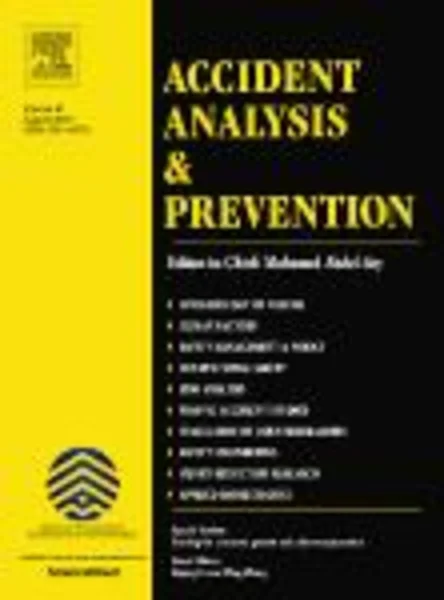-
simulated driving under the influence of extended wake, time of day and sleep restriction
جزئیات بیشتر مقاله- تاریخ ارائه: 1392/01/01
- تاریخ انتشار در تی پی بین: 1392/01/01
- تعداد بازدید: 646
- تعداد پرسش و پاسخ ها: 0
- شماره تماس دبیرخانه رویداد: -
simulated driving under the influence of extended wake, time of day and sleep restrictionaround a fifth of all road accidents can be attributed to fatigued drivers. previous studies indicate that driving performance is influenced by time of day and decreases with sustained wakefulness. however, these influences occur naturally in unison, confounding their effects. typically, when people drive at a poor time of day and with extended wake, their sleep is also restricted. hence, the aim of the current study was to determine the independent effects of prior wake and time of day on driving performance under conditions of sleep restriction. the driving performance of fourteen male participants (21.8 ± 3.8 years, mean ±sd) was assessed during a 10 min simulated driving task with speed/lane mean, variability and violations (speeding and crashes) measured. participants were tested at 2.5 h intervals after waking, across 7 × 28 h days with a sleep:wake ratio of 1:5. by forced desynchrony each driving session occurred at 9 doses of prior wake and within 6 divisions of the circadian cycle based on core body temperature. a mixed models anova revealed significant main effects of circadian phase, prior wake and sleep debt on lane violations. in addition, three significant two-way interactions (circadian phase × prior wake, prior wake × sleep debt, sleep debt × circadian phase) and one three-way interaction (circadian × prior wake × sleep debt) were identified. the presence of the large interaction effects shows that the influence of each factor is largely dependent on the magnitude of the other factors. for example, the presence of the time of day influence on driving performance is dependent on the length of prior wake or the presence of sleep debt. the findings suggest that people are able to undertake a low-difficulty simulated drive safely, at least for a short period, during their circadian nadir provided that they have had sufficient sleep and have not been awake too long.
مقالات جدیدترین رویدادها
-
استفاده از تحلیل اهمیت-عملکرد در ارائه الگوی مدیریت خلاقیت سازمانی و ارائه راهکار جهت بهبود
-
بررسی تاثیر ارزش وجوه نقد مازاد بر ساختار سرمایه شرکت های پذیرفته شده در بورس اوراق بهادار تهران
-
بررسی تأثیر سطح افشای ریسک بر قرارداد بدهی شرکت های پذیرفته شده در بورس اوراق بهادار تهران
-
بررسی تأثیر رتبه بندی اعتباری مبتنی بر مدل امتیاز بازار نوظهور بر نقد شوندگی سهام با تأکید بر خصوصی سازی شرکت ها
-
تأثیر آمیخته بازاریابی پوشاک ایرانی بر تصویر ذهنی مشتری پوشاک ایرانی (هاکوپیان)
-
بررسی نقش و اهمیت ارتباط بین علوم روانشناسی در توسعه پایدار علوم انسانی
-
بررسی ارتباط محافظه کاری حسابداری با هزینه سرمایه در شرکت های پذیرفته شده بورس اوراق بهادار تهران
-
تأثیر عوامل آمیختۀ بازاریابی خدمات (7p) بر ترجیح مشتریان در انتخاب بانک ملی (مورد مطالعه : شعب شهرستان بیرجند)
-
مقاومت برشی خاک های غیر اشباع در شیروانی های خاکی
-
triple-frequency carrier ambiguity resolution for beidou navigation satellite system
مقالات جدیدترین ژورنال ها
-
مدیریت و بررسی افسردگی دانش آموزان دختر مقطع متوسطه دوم در دروان کرونا در شهرستان دزفول
-
مدیریت و بررسی خرد سیاسی در اندیشه ی فردوسی در ادب ایران
-
واکاوی و مدیریت توصیفی قلمدان(جاکلیدی)ضریح در موزه آستان قدس رضوی
-
بررسی تاثیر خلاقیت، دانش و انگیزه کارکنان بر پیشنهادات نوآورانه کارکنان ( مورد مطالعه: هتل های 3 و 4 ستاره استان کرمان)
-
بررسی تاثیر کیفیت سیستم های اطلاعاتی بر تصمیم گیری موفق در شرکتهای تولیدی استان اصفهان (مورد مطالعه: مدیران شرکتهای تولیدی استان اصفهان)
-
طراحی الگوی درمان مبتنی بر پذیرش و تعهد بر اساس اسلام
-
تاثیر سرمایه فکری بر رابطه بین حاکمیت شرکتی و عملکرد شرکت های پذیرفته شده در بورس اوراق بهادار تهران
-
اثربخشی مداخله مبتنی بر تنظیم هیجان بر راهبردهای نظم دهی شناختی هیجانی و ناگویی هیجانی در بیماران مبتلا به نارسایی عروق کرونر قلب
-
مشارکت زنان در انتخابات از دیدگاه فقه اسلامی با تأکید بر فرهنگ ملی افغانستان
-
the study of substituent effect on osmabenzene complexes




سوال خود را در مورد این مقاله مطرح نمایید :